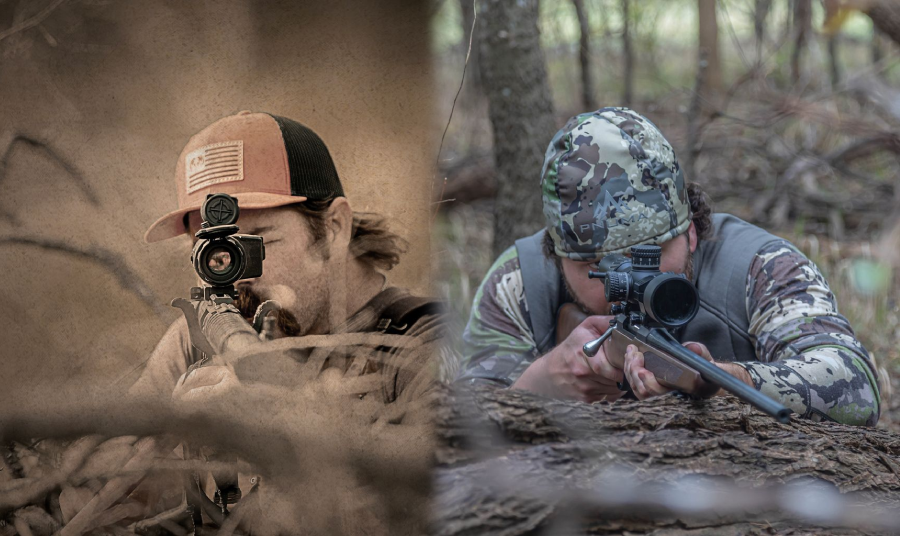So, you’ve got yourself a new riflescope—nice! But before you start turning targets into Swiss cheese, you need to zero your scope. This is the first thing you need to do when setting up any optic, and it ensures that what you see in your crosshairs is exactly where your bullet will go. Zeroing isn’t just a one-size-fits-all affair either; the distance you zero at affects your accuracy at other ranges. Zero at 50 yards, and things look pretty good out to 200. Zero at 100 yards, and you might be high or low at other distances. However, not all riflescopes are the same, and there are some fundamental differences between the digital and traditional varieties of riflescopes.
How to Zero a Traditional Riflescope
These are the bread and butter for most shooters—simple, rugged, and reliable. When you zero a traditional riflescope such as the Sightmark Presidio 3-18x50, you're adjusting the windage and elevation turrets to change the point of impact. You are not moving your reticle. Instead, if you look through your ocular lens as you zero a traditional riflescope, you notice the target is moving according to the direction you’re rotating your windage and elevation turrets in.
Here’s how it works: you shoot, check your shot placement, and then twist the turrets to adjust the point of impact until it aligns with the reticle. Usually, a 100-yard rifle target with grid squares will have each grid square equivalent to 1 MOA. Pay attention to those click values—usually 1/4 MOA or 1/10 MIL per click. Sure, it takes some practice and patience, but it’s also a great way to get to know your optic and rifle better. Plus, there’s something undeniably satisfying about the tactile feel of those turret clicks.

Tightening the screws on scope rings is usually only a concern to those who use traditional daytime riflescopes.
How Digital Zeroing Works
Unlike traditional scopes, digital ones come with a whole suite of high-tech features such as thermal vision and video recording. Some of them even have ballistic calculators. But the biggest difference is how they’re zeroed. The Sightmark Mini Thermal, for example, is zeroed from a menu system where, instead of turrets manipulating lenses, the device is zeroed by moving an image of the reticle within the device itself.
To zero a digital scope, you fire a shot at your target, check where it hits, and then dive into the scope’s menu. Using the buttons, you move the on-screen reticle to where the bullet impacted. No twisting knobs, no guesswork—just a few taps of a button, and you’re dialed in. This process is not only straightforward but, thanks to the Wraith Mini Thermal’s five different weapon profiles, also gives you the flexibility to save different zeroes for different ammo or guns.
Digital vs Traditional Zeroing: Which One Is Right for You?
Whether you have a digital or a traditional optic, the end goal is the same: getting those shots on target. Digital scopes like the Sightmark Wraith Mini Thermal bring some cool tech to the table, making the zeroing process quicker and offering features that go beyond the basics. But traditional scopes aren’t going anywhere—they’ve got the reliability and the tactile satisfaction that many shooters love—plus they don’t rely on batteries. So, choose the one that fits your style, get that optic zeroed, and start stacking up those bullseyes. After all, it doesn’t matter how you get there, as long as you’re hitting what you’re aiming at!
To shop Sightmark's traditional riflescopes, click here.
To shop Sightmark's digital riflescopes, click here.
Frequently Asked Questions
What is zeroing a riflescope and why is it important?
Zeroing a riflescope is the process of adjusting the scope to ensure that the point of impact aligns with the reticle. It is important because it ensures that what you see in your crosshairs is exactly where your bullet will go.
How does zeroing a traditional riflescope differ from zeroing a digital riflescope?
Zeroing a traditional riflescope involves adjusting windage and elevation turrets to change the point of impact, while zeroing a digital riflescope is done through a menu system by moving an image of the reticle within the device.
What are some key features of digital riflescopes compared to traditional riflescopes?
Digital riflescopes come with features such as thermal vision, video recording, and ballistic calculators, which are not typically found in traditional riflescopes.
How can one tell if a riflescope is traditional or digital?
One way to tell if a riflescope is traditional or digital is by observing the method of zeroing - if it involves adjusting physical turrets, it is likely traditional, whereas if zeroing is done through a menu system, it is likely digital.
What are some advantages of zeroing a digital riflescope over a traditional riflescope?
Zeroing a digital riflescope is often more straightforward and precise, as adjustments are made digitally through a menu system rather than physically turning turrets. Digital scopes also offer the flexibility to save different zeroes for different ammo or guns.




